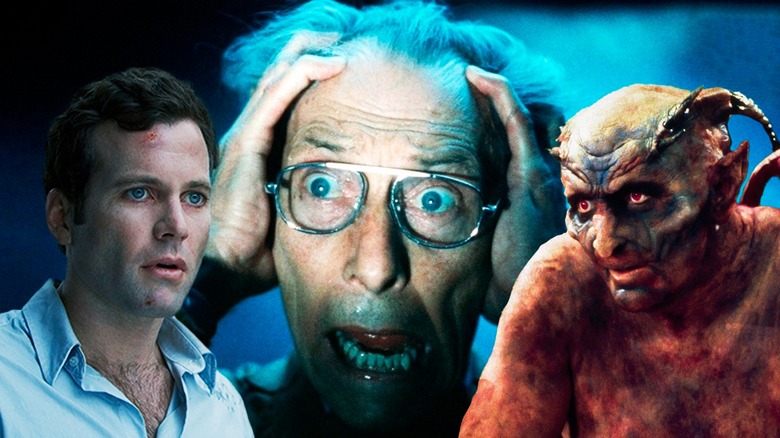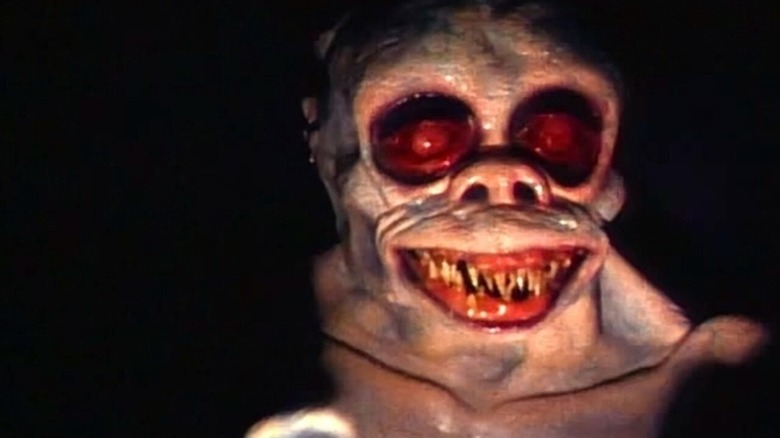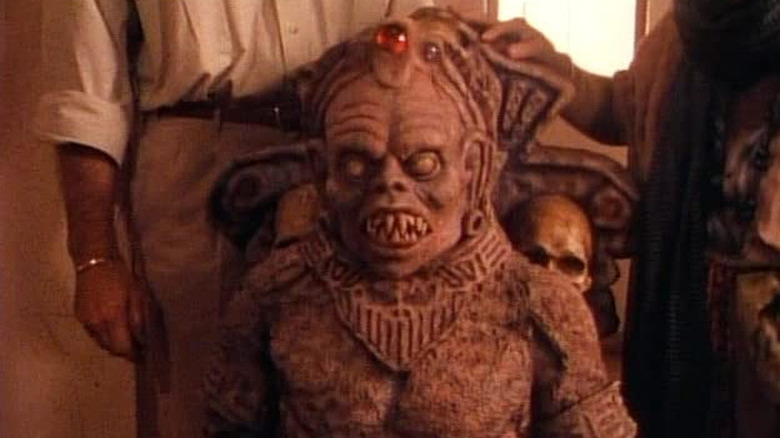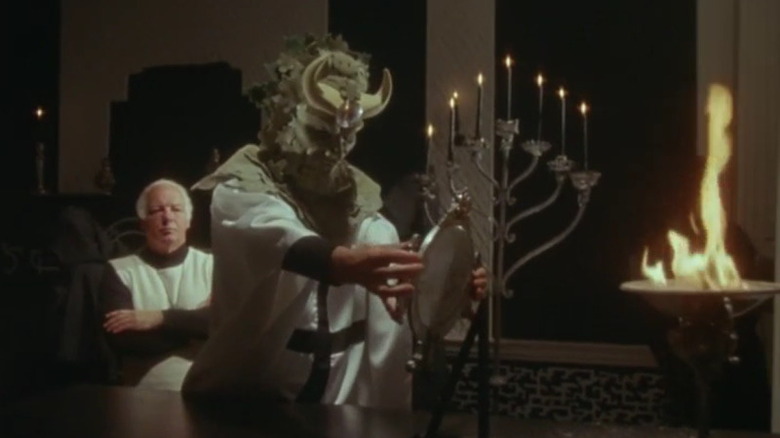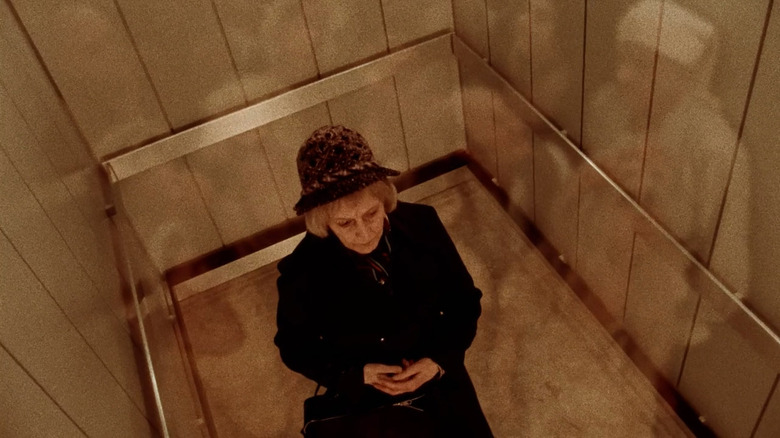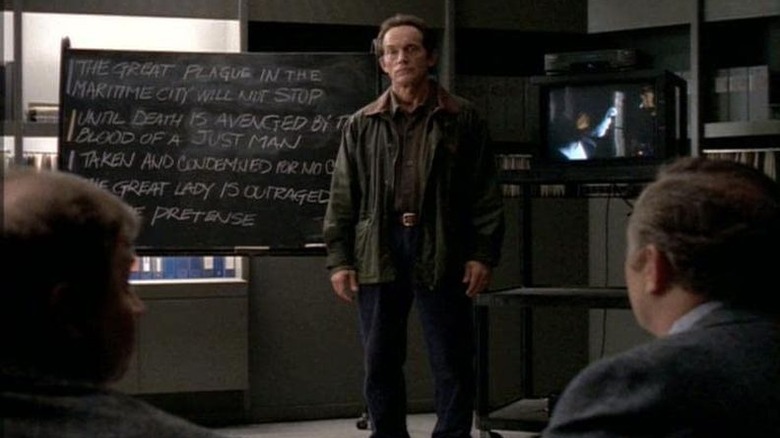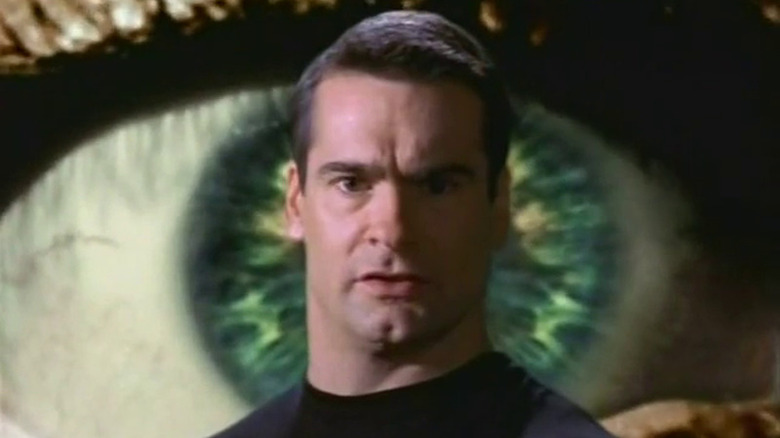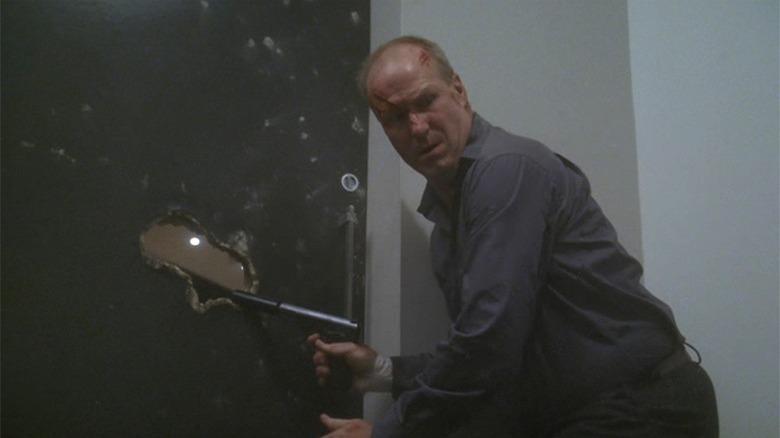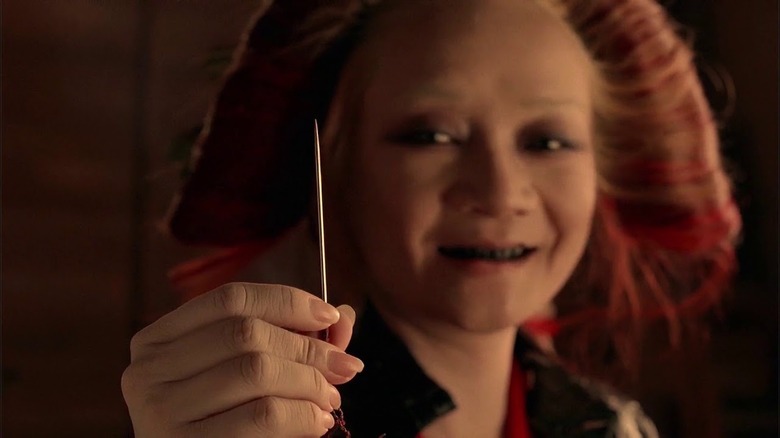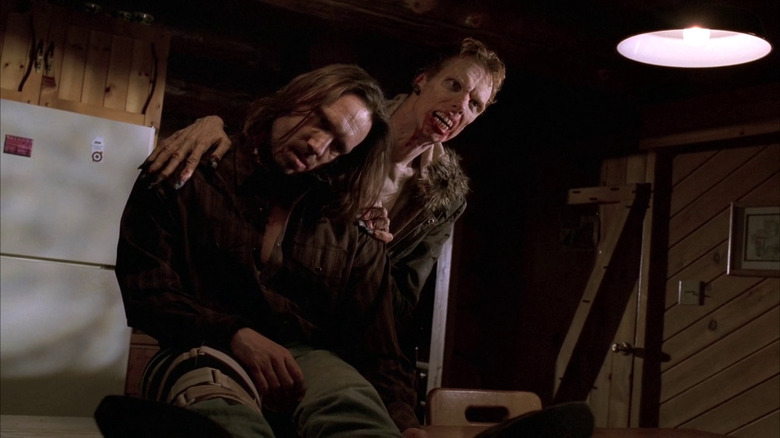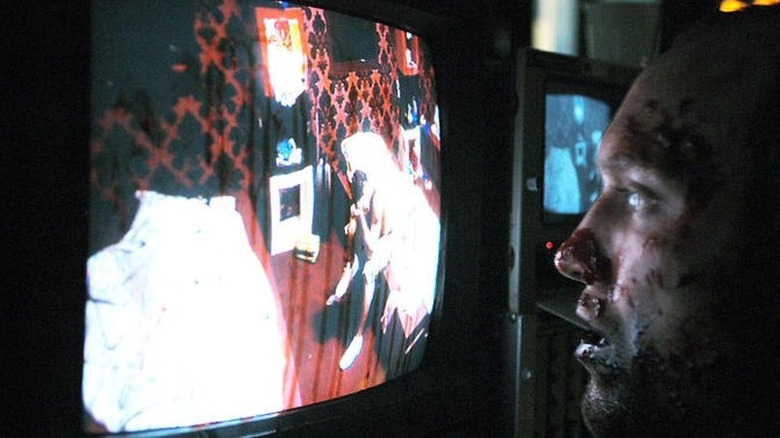Underrated Horror Shows That Deserve Your Attention
In the age of streaming television, horror is alive and well. Shows like "Stranger Things" and "Wednesday" are topping Netflix's charts, "What We Do in the Shadows" continues to prove series adaptations of movies can be even better than the source material, and although "The Walking Dead" came to a conclusion with its 11th season, its multiple spin-offs are certain to keep its spirit shambling along for years to come. But what if you're looking for something off the beaten path?
The good news is that there's a whole world of horror television lurking in the shadows, hungrily waiting for its next captive audience. From old-school anthology series to a Danish supernatural hospital drama, or even obscure relics of the Y2K age, we've put together a lineup of forgotten or simply underappreciated shows that are worth checking out. While some of these might take a little elbow grease to get your hands on in the modern day, there's sure to be something to tickle your scary bone.
Tales from the Darkside
In 1982, George A. Romero teamed up with Stephen King and SFX wizard Tom Savini to produce one of the best, most stylish and memorable horror anthology films of all time: "Creepshow." While its legacy continues to this day in the form of Shudder's 2019 television reboot of the same name, we'd love to see a resurgence in appreciation for its lesser-known spiritual predecessor, "Tales from the Darkside."
Satisfied with the reception of "Creepshow," Romero and production company Laurel Entertainment were eager to expand the premise into an ongoing television series. While intellectual property disputes with Warner Bros. required them to make creative changes including rebranding to "Tales from the Darkside," the anthology show ran successfully over four seasons between 1983 and 1988. Much like "Creepshow," "Darkside" made the most of limited production value, adapting stories by authors including King, Clive Barker, and Harlan Ellison.
It might not have boasted the cable budget or star power enjoyed by HBO's "Tales from the Crypt" less than a decade later, but the show is still replete with impressive creature effects, larger-than-life performances, and chilling tales across its nearly one-hundred-episode run. The series pilot "Trick or Treat," or "The Devil's Advocate" starring Jerry Stiller as a bitter talk-show radio host, are great places to start for any horror fans considering stepping over to the dark side.
Monsters
There's something to be said for shows that do exactly what they say on the tin. That's precisely the case with "Monsters," an anthology series from the same producers behind "Tales from the Darkside." Airing from 1988 to 1991 across three seasons, "Monsters" aimed to showcase creatures big and small, and is a must-see if you're a sucker for practical special effects.
One of the major reasons so many of us adore the horror films of the 1980s is the imagination and technical wizardry behind creature effects of the era. It's impossible to not be impressed by the work on display in films like "The Thing," "The Blob," or "Killer Klowns from Outer Space." While "Monsters" was a much cheaper production than its cinematic counterparts, the special effects were handled by a team overseen by industry legend Dick Smith ("The Exorcist," "Scanners") and the same love of the weird and wonderful is on display across its 72 episode run.
"Monsters" won't be for everyone; it's campy, low-budget, and clearly aimed at being more accessible to younger audiences. But if the likes of Steve Buscemi, Debbie Harry, Meat Loaf, and "Hellraiser" scream queen Ashley Laurence starring alongside a cavalcade of larger-than-life ghouls and mutants sounds like your kind of fever dream, give it a spin.
Hammer House of Horror
There are few names as synonymous with classic horror cinema as Hammer. While the studio was responsible for some of the most iconic depictions of characters like Dracula, Doctor Van Helsing, and Frankenstein's Monster (among many other brilliant horror classics), their struggles to keep up with the competitive media landscape of the '70s and '80s resulted in some of their most intriguing projects. Among those is the 1980 anthology television series "Hammer House of Horror," an enjoyable little relic of the studio's most turbulent era.
Created by Roy Skeggs, a long-time producer at Hammer, the series had a run of 13-hour-long episodes focusing on different subgenres of horror. From witches and werewolves to mad doctors and cannibals, "House of Horror" presented eerie original tales without relying on their most famous properties. In addition to including previous Hammer collaborators like Peter Cushing and director Peter Sasdy, "House of Horror" was also a source of early acting roles for future stars Brian Cox and Pierce Brosnan.
"Hammer House of Horror" is interesting as a product of the time in which it was produced; it's also a simply entertaining and underrated gathering of Hammer talent in short form. Given that the show has been remastered and re-released in recent years, it's a fine addition to any old-school horror fan's collection.
The Kingdom
As David Lynch and Mark Frost proved with "Twin Peaks," television is more than capable of capturing the essence of cinema's auteurs for a small-screen audience. Lars von Trier and Niels Vørsel clearly agreed with this notion in 1994 when they created "The Kingdom," a surreal blend of supernatural horror and black comedy taking place in the neurological ward of a Danish hospital.
After a psychic patient makes contact with the spirit of a young girl in the depths of the Rigshospitalet, its staff and patients must band together to solve the building's many mysteries and stop an ancient evil force from escaping into our world. Like "Twin Peaks" before it, "The Kingdom" combines seemingly opposing genres to brilliant effect, balancing quirky hospital soap opera tones with body horror and supernatural scares in absolute confidence.
Its characters are loveable even at their most despicable, its plots are ridiculous, and it features one of genre icon Udo Kier's greatest (and grossest) roles to date. It's a crying shame that it was canceled after just two seasons, but much like the spirits that roam the Rigshospitalet's halls, the show lives on with the revival series "The Kingdom: Exodus." There's never been a better time to check-in.
Millennium
"The X-Files" is one of the most popular horror/science fiction TV series of all time, and with good reason. Despite fumbling the execution of its broader story arc and declining quality in later seasons, there are more than enough brilliant standalone episodes to qualify it as one of the greats of genre television. But we'd also love to see renewed awareness and appreciation of its sister series "Millennium," a short-lived but utterly chilling fusion of doomsday paranoia, crime drama, and the supernatural.
With the runaway success of "The X-Files" at Fox, creator Chris Carter was given the opportunity to try and replicate that same magic for the network. Airing between 1996 and 1999, "Millennium" was — for the most part — treated as a separate entity from "The X-Files." Led by Lance Henriksen ("Alien") as former FBI agent Frank Black, the show followed Black's investigation of bizarre criminal cases and the conspiracies surrounding the shadowy Millennium Group.
Despite its merits, "Millennium" was canceled by Fox after its third season due to low viewership, and the character Frank Black was officially retired for good in a crossover episode of "The X-Files" during that show's seventh season. Nonetheless, if you're looking for a horror series with strong performances, compelling mythology, and some bonkers ideas, "Millennium" could be your new obsession.
Night Visions
There are plenty of noteworthy horror series that come and go without leaving much of a footprint behind, and one we can't get out of our heads is Fox's "Night Visions." Hosted by hardcore punk frontman and actor Henry Rollins and starring a great lineup of familiar faces from genre television, "Night Visions" is an oddball series deserving of reappraisal.
"Night Visions" squeezed two half-hour segments into each hour-long episode, some of which were directed by horror legends including Joe Dante, Tobe Hooper, and Ernest Dickerson. Serial killers, voodoo, life after death, dysfunctional families, killer bears — despite only running for 13 episodes, "Night Visions" managed to pack all kinds of strange tales into its brief stint on the air.
With stars including Malcolm McDowell, Pam Grier, Timothy Olyphant, Natasha Lyonne, Sherilyn Fenn, and Bill Pullman (who also directed the episode "A View Through the Window"), you'd think that "Night Visions" would be more well-known in the horror space. With no physical or streaming release, the series is stuck in the realms of old VHS recordings and local syndication broadcasts. In some way, there's something charming about that, but we'd love to see it accessible to all.
Nightmares and Dreamscapes: From the Stories of Stephen King
For life-long Stephen King fans, news of a King adaptation is a mixed bag of feelings. While there have been some true knock-out cinematic and televised takes on the author's work ("The Shawshank Redemption," "The Stand") there have been plenty of duds, too. "Nightmares & Dreamscapes: From the Stories of Stephen King," which ran on TNT back in 2006, isn't among the best-known or acclaimed stabs at bringing his stories to television, but it's a fun one-off with some notable talent behind the scenes.
As the name suggests, five of the eight episodes of "Nightmares & Dreamscapes" are pulled from King's short story collection of the same name. There are some familiar faces here: William H. Macy hams it up as a noir detective in "Umney's Last Case," and the late William Hurt stars as a hitman under siege by living toy soldiers in the show's best episode, "Battleground." (The latter is appropriately directed by Brian Henson, of "Muppets" fame.)
Admittedly, the series would have benefited from drawing from earlier King collections like "Skeleton Crew" and "Night Shift," which are full of back-to-back goosebumps factories of stories. But the episodes that do work in "Nightmares" are worth the price of admission alone, as evidenced by the five nominations and two wins the series landed at the following year's Emmy Awards. Tune in, Constant Readers.
Masters of Horror
If you're a fan of Guillermo del Toro's "The Cabinet of Curiosities" on Netflix, this one's for you. Inspired by his regular dinner gatherings with fellow masters of the craft (including del Toro himself), horror legend Mick Garris teamed up with Showtime to create "Masters of Horror," an anthology horror series with episodes written and directed by some of the genre's biggest names.
Across its two-season run, "Masters" featured original stories and adaptations of works by Joe R. Lansdale, H.P. Lovecraft, Clive Barker, and more. Thanks to the wonders of airing on a cable network, the series was considerably darker and more adult than many older horror anthology series. In fact, an episode by Takashi Miike ("Audition," "Ichi the Killer") was so violent that Showtime pulled it from the schedule. (We totally recommend checking out "Imprint" if you've got a strong stomach.)
As with just about any anthology series, "Masters of Horror" has its highs and lows. But its strongest episodes — including "Cigarette Burns" by John Carpenter, "Incident On and Off a Mountain Road" by Don Coscarelli, and "Sick Girl" by Lucky McKee — are among some of the weirdest and most wonderful episodes of modern horror television around.
Fear Itself
Even though Showtime pulled the plug on "Masters of Horror” after its second season, Mick Garris wasn't ready to give up on the anthology experiment. From the ashes of its predecessor, "Fear Itself" aired on NBC in 2008, featuring 13 episodes written and directed by cult and more well-known horror creatives. While it never quite hit the highs of "Masters," there are some hidden gems to enjoy in this short-lived series.
In one of the series' most unsettling episodes, "Skin & Bone," monster performer extraordinaire Doug Jones stars as the patriarch of a rural family who goes missing during a hunting expedition. Although he returns from the freezing wilds, there's something very wrong with Dad. Larry Fessenden, who horror fans may recognize from Travis Stevens' "Jakob's Wife" alongside Barbara Crampton, directs from a teleplay by "Masters of Horror" alums Drew McWeeny and Rebecca Swan.
It's creative combinations like these that make an anthology series so fun, and Mick Garris' ability to corral some of the most devilish minds in horror together is truly impressive. "Fear Itself" only managed to air half of its episodes before being permanently bumped from its usual slot by NBC's broadcast of the 2008 Summer Olympics, leaving the show unable to ever find its footing. Nonetheless, it's worth seeking out for anyone on the hunt for some solid anthology frights.
Dead Set
You won't find "Black Mirror" on this list. It's a superb and frequently horrifying sci-fi anthology show, but it's hardly underrated. Instead, you should cast your television-viewing gaze back to 2008, when "Black Mirror" co-creator Charlie Brooker produced a five-episode series that combines "Dawn of the Dead" with "Big Brother" to hilariously bleak results.
Directed by Yann Demange ("Lovecraft Country") and written by Brooker, "Dead Set" follows a group of survivors hiding out from a zombie outbreak on the set of the reality television series "Big Brother." With a cast including Academy Award winner Riz Ahmed, frequent Chris Morris collaborator Kevin Eldon, and a variety of real-life "Big Brother" contestants, the show exercises Brooker's signature cynicism and black comedy sensibilities, as the survivors' clashing personalities threaten the safety of their televised fortress.
Like the films it draws inspiration from, including George A. Romero's "Dead" trilogy and Danny Boyle's "28 Days Later," "Dead Set" succeeds at both entertaining and frightening audiences through its gruesome gore effects and biting social commentary. Brooker's television production empire has grown impressively in recent years in partnership with Netflix, but his earlier work contains some real hidden gems.
